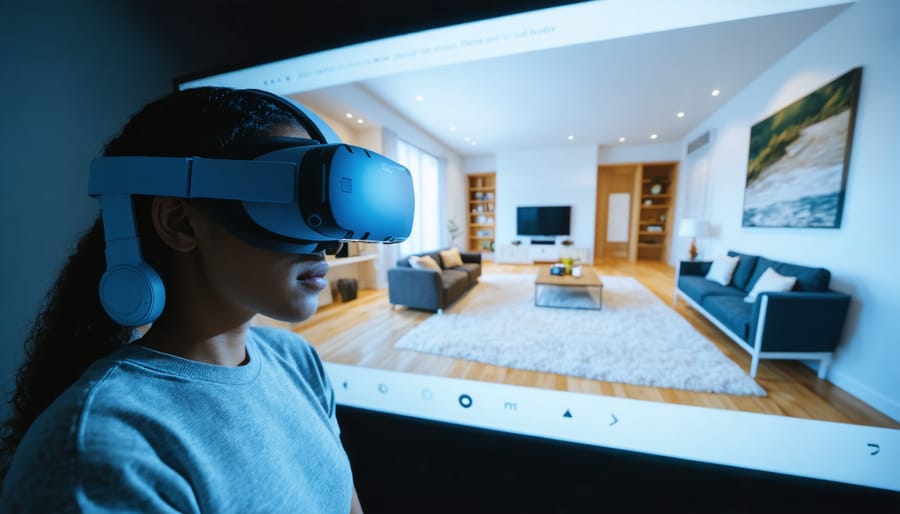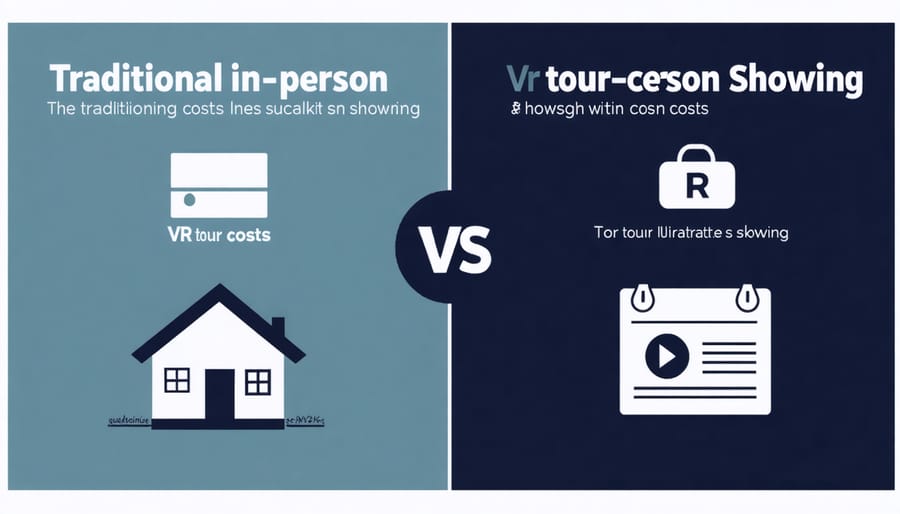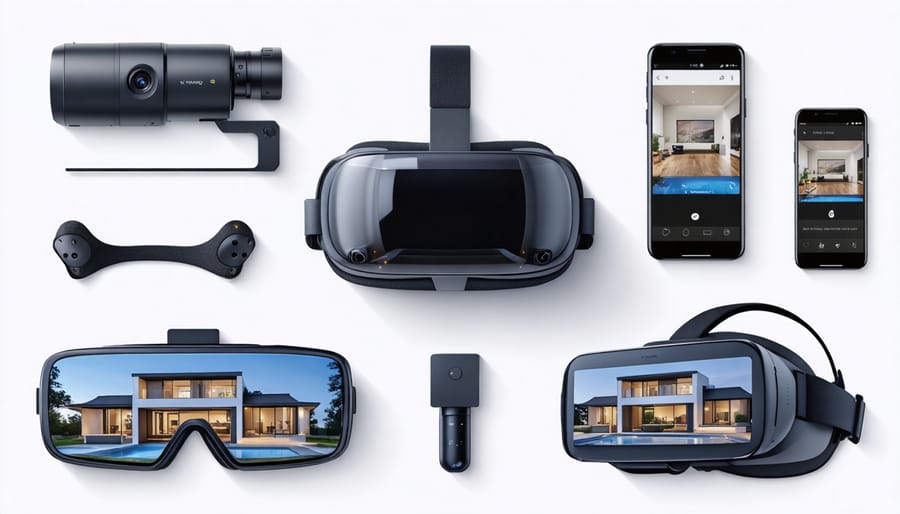Virtual reality tours are revolutionizing real estate tours by transforming how properties are showcased and sold in today’s digital marketplace. This technology enables potential buyers to explore homes from anywhere in the world, delivering an immersive experience that traditional photos and videos simply cannot match. For real estate professionals, VR tours have become a game-changing tool, reducing showing time by up to 50% while significantly increasing engagement rates among prospective buyers.
The impact extends beyond convenience—VR tours are driving measurable business results. Properties featuring virtual walkthroughs receive 87% more views than listings without them, and buyers are 95% more likely to call about properties they’ve toured virtually. As the real estate market continues to embrace digital innovation, VR tours have evolved from a luxury addition to an essential component of successful property marketing strategies, offering unprecedented ROI for agents and sellers alike.
How VR Property Tours Work
Technology Behind Virtual Tours
Virtual tours represent one of the most transformative real estate tech trends, powered by sophisticated yet user-friendly technology. At the heart of these immersive experiences are 360-degree cameras, which capture complete room views in stunning detail. Popular models like the Ricoh Theta and Matterport Pro2 have become industry standards, offering professional-grade imagery with minimal setup.
The magic happens when specialized software transforms these captures into seamless virtual experiences. Platforms like Matterport, 3DVista, and Zillow 3D Home combine these images to create interactive walkthroughs, complete with measurement tools and hotspots for additional information. These solutions automatically generate floor plans and offer dollhouse views, giving potential buyers a comprehensive understanding of the property’s layout.
For maximum accessibility, most virtual tours are web-based, requiring no special equipment to view. However, for a more immersive experience, VR headsets like Oculus Quest or HP Reverb can transport viewers directly into the space. Cloud hosting services ensure these tours load quickly and can be easily shared across multiple listing platforms.
The technology is continuously evolving, with newer features including AI-powered staging options, automated highlight reels, and integration with property management systems. This makes virtual tours not just a viewing tool, but a comprehensive property marketing solution.

Types of Virtual Property Tours
Virtual property tours come in three main varieties, each offering unique advantages for real estate professionals and potential buyers. Guided VR tours provide a personalized experience where an agent remotely walks clients through the property in real-time, pointing out key features and answering questions immediately. This option is particularly valuable for high-end properties or when buyers require detailed explanations about specific aspects of the home.
Self-guided tours give prospective buyers the freedom to explore properties at their own pace and on their own schedule. Users can navigate through the space using intuitive controls, zoom in on details that interest them, and revisit areas multiple times. This format is especially popular among tech-savvy buyers who prefer independent exploration.
Interactive VR tours take the experience to the next level by incorporating clickable hotspots, measurement tools, and customization options. Viewers can access additional information about features like appliances or materials, measure room dimensions, and even experiment with different furniture layouts or color schemes. Some advanced platforms allow users to switch between day and night lighting conditions or view seasonal changes in outdoor spaces.
Each tour type can be enhanced with 360-degree photography, 3D modeling, or full VR headset compatibility, depending on your budget and technical requirements. The choice between these options often depends on your target market, property type, and desired level of client engagement.
Financial Benefits for Real Estate Professionals

Cost Reduction in Property Showings
Virtual reality tours represent a significant cost-saving opportunity for real estate professionals and property owners. The most immediate savings come from reduced travel expenses, as agents no longer need to drive to multiple properties for individual showings. On average, real estate agents can save 20-30% on fuel costs and vehicle maintenance by implementing VR tours as their primary showing method.
Time savings are equally substantial. Traditional property showings typically require 1-2 hours per viewing when accounting for preparation, travel, and the actual showing. VR tours eliminate this time investment, allowing agents to serve more clients efficiently. A single high-quality VR tour can replace dozens of physical showings, freeing up valuable hours in an agent’s schedule.
Property staging costs also see significant reduction through VR technology. Traditional staging can cost between $2,000 to $8,000 per property, depending on size and market. Virtual staging, by comparison, typically costs $200-600 per property and can be easily modified for different style preferences. This represents an average saving of 75% on staging expenses.
Additionally, VR tours reduce wear and tear on properties from repeated showings, lowering maintenance costs and preserving the property’s condition. Property owners benefit from fewer disruptions to tenants or their daily routines, while saving on cleaning services typically required after physical showings.
These combined savings make VR tours an increasingly attractive investment for real estate professionals looking to optimize their operations and reduce overhead costs.
Increased Property Exposure and Sales
Virtual reality tours have revolutionized property marketing, significantly boosting exposure and sales metrics across the real estate industry. Recent data from the National Association of Realtors shows that listings with virtual tours receive 87% more views compared to those without, leading to faster sales and higher engagement rates.
Properties featuring VR tours typically sell 31% faster than those with traditional listings, with an average reduction in time-on-market of 6-8 weeks. This increased efficiency translates directly to cost savings and improved ROI for real estate professionals.
The global reach of virtual tours has been particularly impactful, with international buyers increasingly relying on VR technology to make purchase decisions. Statistics indicate that 92% of overseas property investors prefer listings with virtual tours, and 75% are more likely to schedule an in-person viewing after experiencing a VR presentation.
Conversion rates have also seen remarkable improvement. Properties marketed with VR tours experience a 40% higher conversion rate from inquiry to showing, and a 95% reduction in wasted viewings. Real estate agents report that qualified leads increase by approximately 65% when incorporating virtual tours into their marketing strategy.
For luxury properties, the impact is even more pronounced, with high-end listings featuring VR tours generating 403% more inquiries compared to those using traditional photography alone. This technology has proven particularly valuable in reaching affluent buyers who prioritize convenience and efficiency in their property search.
Implementation Strategies

Choosing the Right VR Solution
When selecting a VR solution for your real estate business, it’s essential to consider both your budget and specific needs. The market offers several tiers of VR platforms, ranging from basic 360-degree photo tours to fully immersive 3D experiences.
Entry-level solutions like Matterport and Zillow 3D Home are popular choices for agents starting with virtual tours. These platforms offer user-friendly interfaces and reasonable pricing, typically charging per property or through monthly subscriptions. Matterport, in particular, has become an industry standard, providing excellent image quality and easy integration with multiple listing services (MLS).
For those seeking higher-end solutions, platforms like iStaging and EyeSpy360 offer advanced features such as interactive hotspots, detailed floor plans, and virtual staging capabilities. These platforms generally require a bigger investment but deliver more sophisticated presentation options and better engagement metrics.
Custom solutions from specialized VR development companies offer the highest level of customization and quality. While these can cost significantly more, they’re worth considering for luxury properties or large real estate portfolios where presentation quality is paramount.
When evaluating providers, consider these key factors:
– Equipment compatibility and requirements
– Ease of use for both agents and viewers
– Integration capabilities with your existing systems
– Mobile accessibility and performance
– Customer support quality
– Pricing structure and scalability
– Data analytics and reporting features
Remember to request demos and trial periods before committing to any platform. This hands-on experience will help you assess whether the solution meets your specific needs and provides value for your investment. Many providers also offer training and support packages, which can be crucial for successful implementation.
Marketing VR Tours to Clients
Successfully marketing VR tours requires a strategic approach that combines traditional marketing strategies for real estate with innovative digital promotion techniques. Start by showcasing the value proposition to your clients: VR tours save time, offer convenience, and provide an immersive experience that traditional photos simply can’t match.
Create compelling promotional materials that highlight these benefits through various channels. Use social media platforms to share short clips of your VR tours, demonstrating the technology’s capabilities and the property’s best features. Email marketing campaigns can include sample VR tour links, allowing potential clients to experience the technology firsthand.
Education is crucial for client adoption. Develop simple tutorials or guides that explain how to navigate VR tours using different devices. Host small workshops or webinars demonstrating the technology to fellow agents and potential clients. Address common concerns about technology barriers by emphasizing that most VR tours are accessible through standard smartphones and computers.
Leverage testimonials from satisfied clients who have successfully sold or purchased properties using VR tours. Share success stories highlighting how virtual tours helped out-of-state buyers make confident decisions or how sellers received multiple offers without countless in-person showings.
Consider offering VR tours as part of a premium marketing package. Position the technology as a modern, sophisticated tool that gives listings a competitive edge in the market. Track and share metrics about viewing times, engagement rates, and successful sales to demonstrate the ROI to skeptical clients.
Remember to emphasize how VR tours complement, rather than replace, traditional showings. This technology serves as an efficient screening tool that brings more serious buyers to in-person viewings, ultimately saving time and resources for all parties involved.
Insurance and Legal Considerations
As virtual reality tours become increasingly prevalent in real estate, it’s crucial to understand the insurance and legal implications of implementing this technology. Property owners and real estate professionals must ensure they have adequate coverage to protect against potential risks and liabilities.
First, consider professional liability insurance that specifically covers virtual reality implementations. This coverage protects against claims arising from technical errors, misrepresentation of property features, or virtual tour malfunctions. Many standard real estate insurance policies may not explicitly cover VR-related incidents, making it essential to review and potentially upgrade existing coverage.
Data protection insurance is another vital consideration, particularly as VR tours involve collecting and storing digital property information. Implementing robust digital security measures is crucial, but having insurance coverage for potential data breaches or cyber attacks provides an additional layer of protection.
Property owners should also consider updating their liability waivers to address VR-specific concerns. These waivers should clearly outline the limitations of virtual tours and protect against claims related to discrepancies between virtual and physical property features.
Key legal considerations include:
– Copyright protection for virtual tour content
– Privacy policies covering data collection during VR experiences
– Terms of service for virtual tour access
– Compliance with accessibility regulations
– Disclosure requirements regarding virtual staging or modifications
Working with an insurance professional who understands both real estate and technology can help ensure comprehensive coverage. They can assess specific risks associated with your VR implementation and recommend appropriate coverage levels and policy types.
Remember to regularly review and update insurance policies as VR technology evolves and new risks emerge. Stay informed about industry standards and best practices to maintain adequate protection while leveraging the benefits of virtual reality tours.
Virtual reality tours have revolutionized the real estate industry, and their role will only become more significant in the coming years. As technology continues to advance, we can expect even more immersive experiences, improved visualization capabilities, and seamless integration with other digital tools. The future points toward AI-powered VR tours that can automatically highlight property features and provide real-time market data during virtual walkthroughs.
For real estate professionals looking to implement VR tours, the time to act is now. Begin by assessing your current marketing strategy and identifying properties that would benefit most from virtual tours. Research reputable VR service providers or consider investing in high-quality equipment for in-house production. Start with a pilot program featuring a few select properties to test the technology and gather client feedback.
Remember that successful implementation requires proper training for your team and clear communication with clients about the benefits of virtual tours. Consider the initial investment as part of your long-term marketing strategy, understanding that VR tours can significantly reduce showing times and increase property exposure.
The shift toward virtual property tours isn’t just a trend – it’s becoming an essential tool in modern real estate. By embracing this technology now, you’ll position yourself ahead of the competition while meeting the evolving expectations of today’s tech-savvy buyers and sellers. The future of real estate showings is virtual, and the possibilities are limitless.